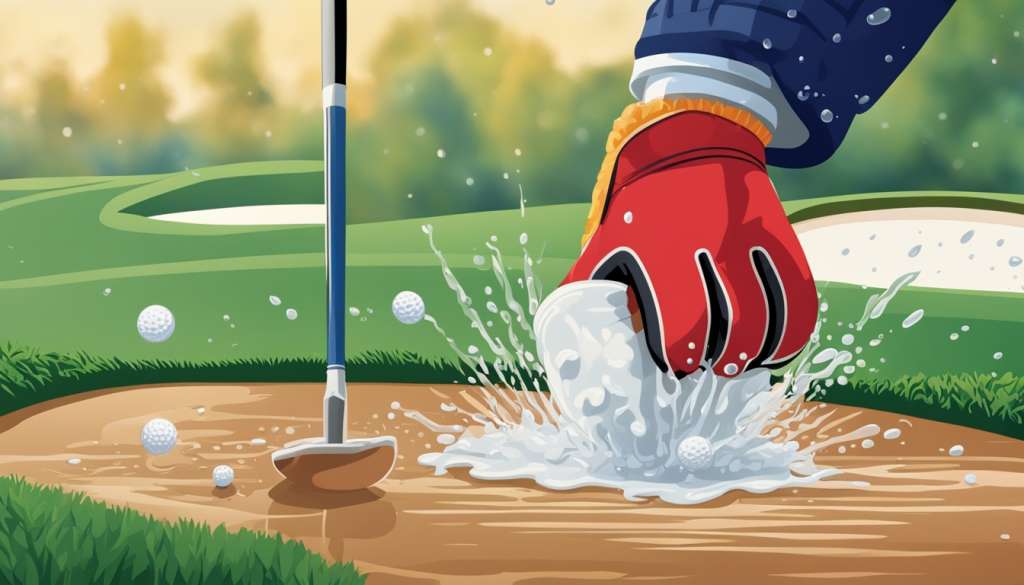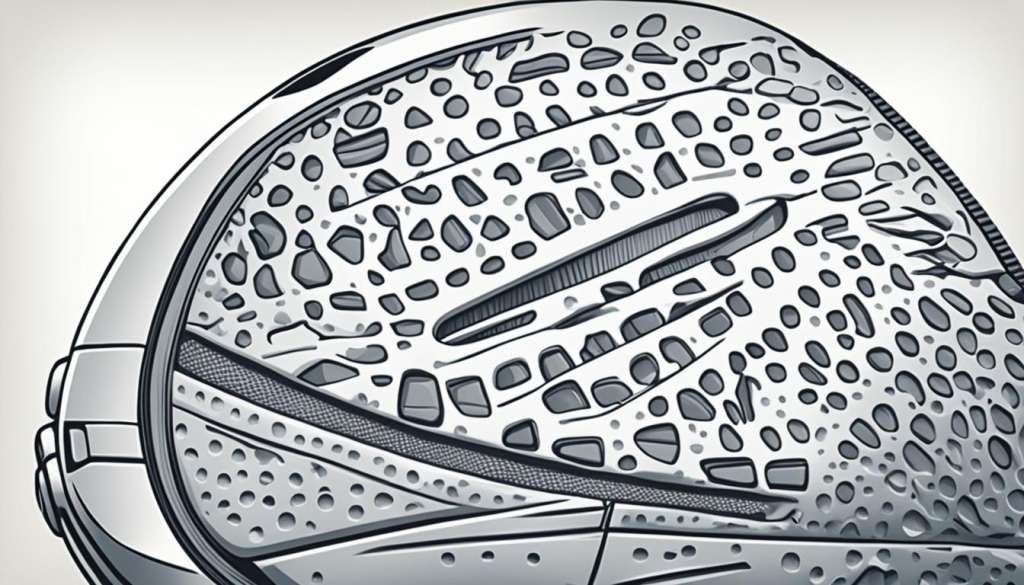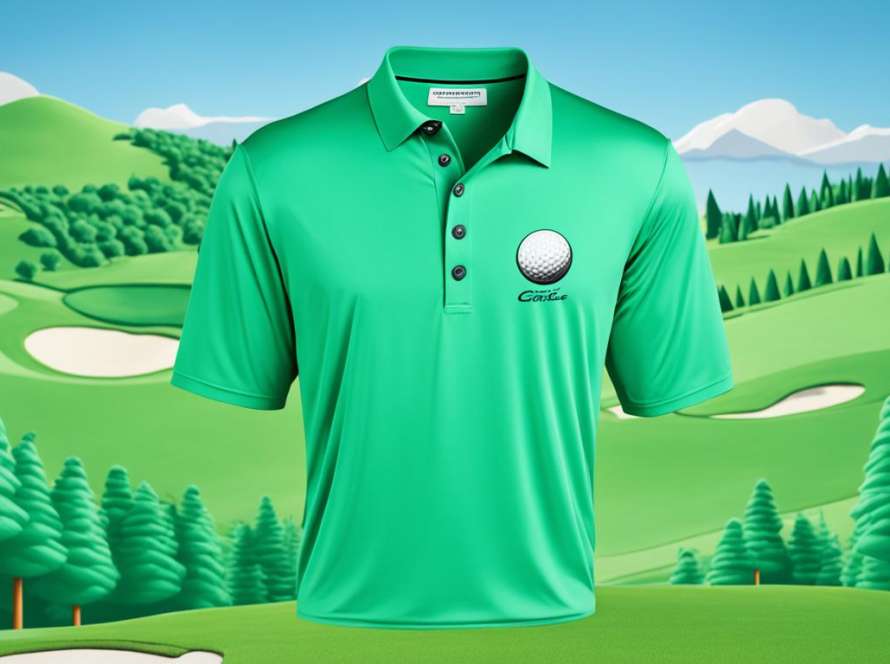Looking for a golf gloves guide? Golf gloves are key for improving your game. They help with grip and boost your performance. Whether you’re new or experienced, knowing about golf gloves can take your game up a notch.
Golf gloves do more than protect your hands. They have a tacky surface that keeps your grip strong, even when it’s hot or humid. This means better control and possibly more accurate shots. While some pros don’t wear gloves, most amateurs find them essential for steady play.
There are many golf gloves to choose from, fitting different needs and budgets. You can pick from premium leather or synthetic materials, each with its own perks. Some gloves are made for certain weather, others for durability or feel. Knowing these differences helps you find the right glove for your style and the course conditions.
Understanding the Importance of Golf Gloves
Golf gloves are key to your game. They boost your performance and keep your hands safe. Let’s see why these accessories are essential for golfers.
The Role of Gloves in Your Golf Game
Golf gloves feel like a second skin. They help you connect better with the club. Most golfers wear one on their non-dominant hand. This setup helps with control and feel during swings.
How Gloves Improve Grip and Control
Golf gloves make your grip better. They create more friction between your hand and the club. This stops the club from slipping, especially when it’s hot or humid. A better grip means more consistent swings and better accuracy.
Protection Against Wear and Tear
Hand protection is a big plus of golf gloves. They protect your skin from the club’s repeated friction. This cuts down on calluses and blisters, letting you play longer without discomfort.
| Benefits | Without Gloves | With Gloves |
|---|---|---|
| Grip | Can be slippery | Enhanced friction |
| Hand Protection | Prone to blisters | Reduced skin damage |
| Club Control | Less stable | Improved stability |
Understanding golf gloves’ importance helps you make better choices for your game. The right glove can greatly improve your performance. It affects everything from grip to hand protection.
Choosing the Right Hand for Your Golf Glove
Choosing the right golf glove is key to doing well on the course. It matters if you’re right-handed or left-handed. This choice affects your grip, control, and how well you play.
Right-handed golfers usually wear their gloves on the left hand. This is because the left hand leads the swing and does most of the gripping. The glove adds extra grip and stability, helping with control during the swing.
Left-handed golfers wear their gloves on the right hand. The same idea applies – the leading hand gets the glove for better grip and control.
Some players, like Tommy Gainey, also wear gloves on both hands. This gives them the best grip and protection but might make them less sensitive.
Many golfers take off their gloves for putting and short shots. This lets them feel the ball better and make precise shots around the green.
| Player Type | Glove Hand | Reason |
|---|---|---|
| Right-handed golfers | Left hand | Lead hand in swing, primary grip control |
| Left-handed golfers | Right hand | Lead hand in swing, primary grip control |
| “Two Gloves” style | Both hands | Maximum grip and protection |
| Putting/Short game | No glove | Enhanced feel for delicate shots |
Your choice of golf glove hand is crucial for your game. Pick based on your dominant hand and what feels right to you. This will help you play your best on the golf course.
Golf Gloves Guide: Materials and Types
Golf glove materials are key to your game. Knowing the types helps you pick the right one for you. Let’s look at the main golf glove categories and their special features.
Leather Golf Gloves
Leather gloves are a top pick for golfers. They give great feel and grip, helping you control your club. Over time, they fit your hand perfectly. Even though they’re pricier, they last a long time.
Synthetic Golf Gloves
Synthetic gloves are light and flexible. They’re cheaper than leather ones. These gloves dry fast and keep their shape. If you play in humid weather, these might be best for you.
All-Weather Golf Gloves
All-weather gloves work well in different conditions. They mix synthetic materials with grip enhancers. These gloves are great for playing in wet or dry weather all year.
Thermal Golf Gloves
For golfing in the cold, thermal gloves keep your hands warm and grippy. They’re thicker but still let you feel the club well. Some even come in pairs for extra warmth.
| Glove Type | Best For | Key Features |
|---|---|---|
| Leather | Feel and grip | Durable, molds to hand |
| Synthetic | Humid conditions | Lightweight, quick-drying |
| All-Weather | Varied conditions | Versatile, enhanced grip |
| Thermal | Cold weather | Warm, good feel |
Pick a golf glove that suits your playing conditions and what you like. A glove that fits well can really boost your game, no matter the material.
Finding the Perfect Fit: Sizing Your Golf Glove
Golf glove sizing is key to your game’s success. A glove that fits well improves your grip and control. But, a glove that doesn’t fit right can mess up your swing. Let’s look at how to size your golf glove for the best performance.
How to Measure Your Hand for a Glove
Getting accurate measurements is crucial for the right fit. Wrap a tape measure around your hand just below the knuckles. Then, measure from the base of your palm to the tip of your middle finger. These steps will guide you in finding your golf glove size.
Regular vs. Cadet Sizing
Golf gloves come in regular and cadet sizes. Regular gloves fit players with normal hand sizes. Cadet gloves are for those with wider palms and shorter fingers. Knowing your hand shape helps pick the right type.
| Feature | Regular Gloves | Cadet Gloves |
|---|---|---|
| Palm Width | Standard | Wider |
| Finger Length | Longer | Shorter |
| Ideal For | Proportionate Hands | Wide Palms, Short Fingers |
Signs of an Ill-Fitting Glove
An ill-fitting glove can hurt your game. Look out for these signs:
- Excess material at fingertips
- Insufficient Velcro closure
- Wrinkles or bunching in the palm
- Restricted hand movement
Your golf glove should feel like a second skin. If you see any of these problems, it’s time to check your glove size again.
Top Brands and Models in Golf Gloves
Looking for the best golf gloves? You’ll find many top brands offering quality, comfort, and performance. These brands help improve your game.
FootJoy is a leader with its Pure Touch Limited model. It uses Cabretta leather for its softness and durability. Titleist Players gloves also use this leather, giving you a great feel and grip.
If you’re on a budget, check out Nike’s Dura Feel VIII and Callaway’s Opti-Fit. They mix synthetic and leather materials for durability and feel without costing too much.
Under Armour and TaylorMade are also making waves in golf gloves. Under Armour’s Spieth Tour glove gives you a pro-level feel. TaylorMade’s Tour Preferred Vivid line adds style with bright colors.
| Brand | Model | Key Feature |
|---|---|---|
| FootJoy | Pure Touch Limited | Premium Cabretta leather |
| Titleist | Players | Tour-level performance |
| Nike | Dura Feel VIII | Affordable quality |
| TaylorMade | Tour Preferred Vivid | Stylish color options |
Women golfers can find special gloves from these brands. They’re made for smaller hands and different grip needs. The best golf gloves offer quality materials, a good fit, and the grip and feel you prefer.
Caring for Your Golf Gloves
Golf glove care is key to keeping your gear in top shape. Cleaning and maintaining your gloves right can make them last longer. This saves you money and keeps your game consistent.
Cleaning and Maintenance Tips
Cleaning your golf gloves is easy. Just use cold water and a mild detergent. Don’t use hot water, as it can shrink the glove. After washing, reshape the gloves and let them air dry.

Extending the Life of Your Gloves
To make your gloves last longer, switch between several pairs. This lets each glove dry fully before the next use, stopping odors and damage. Keep your gloves in a cool, dry spot, away from sunlight to prevent damage.
When to Replace Your Golf Glove
Even with good care, you’ll need to replace your gloves eventually. Look out for these signs it’s time for a new one:
- Holes or thin spots in high-wear areas
- Decreased grip or slipperiness
- Visible stretching or looseness
- Loss of water resistance in all-weather gloves
Regularly check your gloves to make sure you’re playing with the best equipment.
By following these tips, you’ll improve your game and get the best from your golf gear. Well-cared-for gloves offer better grip, control, and protection on the course.
Weather-Specific Golf Gloves
Golf is played in many weather conditions. The right gloves can greatly improve your game. Let’s look at gloves for different weather to help you play your best.
Gloves for Rainy Conditions
Rain golf gloves are key for a good grip in wet weather. They have water-resistant materials and textured palms for better grip. FootJoy makes great rain gloves that keep your grip strong, even when it pours.
Winter Golf Gloves
Winter golf gloves keep your hands warm and don’t lose feel. They’re thicker and may cover your whole hand. Some have thermal lining and windproof materials to fight the cold.
Hot Weather Glove Options
For hot days, choose breathable summer golf gloves. These use light, moisture-wicking materials to keep your hands cool and dry. Look for gloves with holes or mesh for extra air flow.
| Weather Condition | Glove Type | Key Features |
|---|---|---|
| Rainy | Rain golf gloves | Water-resistant, textured palm |
| Cold | Winter golf gloves | Thermal lining, windproof |
| Hot | Summer golf gloves | Breathable, moisture-wicking |
Choosing the right gloves for each weather helps you handle the course better. The right gear keeps your grip strong and your focus sharp, no matter the weather.
What Your Golf Glove Wear Patterns Reveal
Your golf glove does more than protect your hand. It helps with grip analysis and finds swing faults. By looking at golf glove wear patterns, you can learn about your technique. This knowledge lets you make changes to better your game.

Palm wear on your glove often shows hand slippage or a bad grip. If you see a lot of wear here, check how you’re holding the club. A strong, steady grip during your swing helps fix this and boosts control.
Heel wear might mean you’re re-gripping at the top of your swing or holding the club too close. This leads to shots that vary and less power. Work on keeping a steady grip and the right club position to fix this.
Thumb wear is another pattern to watch for. If your glove’s thumb area is worn out, you might be extending your thumb too far down the shaft. This affects your swing and reduces control over the club.
Pay attention to these wear patterns to find ways to improve your grip and swing. Make checking your glove a regular part of your golf routine. This helps you spot and fix issues early, before they become bad habits.
- Palm wear: Check for proper grip and hand positioning
- Heel wear: Evaluate your grip pressure and club placement
- Thumb wear: Assess thumb position on the club shaft
Remember, golf glove wear patterns are unique to each player. Use this info as a starting point for self-analysis or talk to a golf pro. They can give you a detailed grip analysis and advice on fixing any swing faults your glove shows.
Conclusion
Golf gloves are more than just hand protectors. They help improve your grip, control, and overall performance. Choosing the right glove with a good fit boosts your swing confidence and shot consistency.
When picking a golf glove, think about the material, durability, and the weather. Leather gloves give great feel and grip, while synthetic ones work well in different conditions. A good fit means the glove is snug but doesn’t limit your movement, helping you perform better.
It’s important to take care of your golf gloves and replace them when needed. Look at how they wear out to learn more about your grip and swing. This info can help you improve your technique and lower your scores.
Finding and taking care of the perfect golf glove will improve your game. With the right glove, you’ll have better control, more comfort, and the confidence to face any course challenge.

